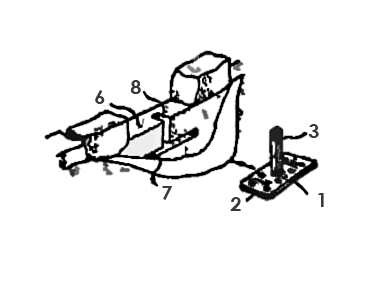
HISTORY OF BASAL IMPLANTS
Dental implantology has also been part of this progress since ancient times and is well documented in the history of dentistry of which there are numerous books and articles published.

Figure 1: Skull of a young woman with the replacement of the second right upper premolar by a phalanx of a finger. The implant of the Neolithic of Faid-Sonard (Algeria) about 9000 years ago.
Conventional dental implantology was developed based on the parameters and guidelines set by Dr. Branemark. He discovered the osseointegration of titanium (which would then be applied in any type of implant discipline) and developed a standard technique with a rigid treatment protocol.
Fortunately for the patients groups of oral surgeons thought of different ways (although they adopted titanium for its property of osseointegration or physiointegration with bone) developing the monophasic implantology (Tramonte, Garbaccio, Mondani, Bauer … etc) and the basal implantology (Scortessi , Sphan, Ihde … etc) of immediate loading, which brings considerable advantages in many of the treatments.
The immediate load consists in putting the teeth in function to the patient in the same surgical act or up to 72 hours later, instead of leaving it with deferred oral handicapped load, a minimum of 2 to 4 months in the best of cases, if we have not performed grafts or other bone augmentation procedures that multiple times and the underlying risk of treatment.
Basal implantology, it was developed and improved in several phases, mainly by French and German dentists.

Figure 2: Form of the lateral implant of Jean-Marc Julliets 1973
The first one-piece basal implant was developed and used by Dr. Jean-Marc Julliet in 1972. Its design was available in two sizes and has been in use, unchanged, to this day. But since homologous cutting tools were not produced for this implant, its use was quite demanding.
It was not until the mid-1980s that the French dentist Dr. Gerard Scortecci presented a complete basal implant system, with its corresponding cutting tools. Together with a group of oral surgeons, he developed two types of implants, called “Diskimplants”, with internal connections and then external ones to the prosthetic superstructure.
Since the mid-1990s in Germany, a group of dentists and oral surgeons have developed new types of basal implants and more precise and appropriate instruments, as well as practical accessories, based on Diskimplant systems. These efforts led to the development of modern basal implants.
In 1997 the German dentist Dr. Stefan Ihde began to produce lateral basal implants in a similar way to the “Diskimplants”. These implants were round and there were not many shapes available. The surface was initially rough.

- Previously round base plates now have anti-rotational edges, this prevented the early rotation of the implants in the bone prior to integration.
- In 2002, the design of a new break-resistant base plate was invented and patented in Europe and the United States.
- Bending zones were introduced into the vertical axis of the implant.
- As of 2005, the experiences with the lateral basal implants were transferred to the designs of the crestal implants BCS, inventing and patenting new models.
As for the structure of the surface in 1999, the vertical parts of the implants were produced polished, and since 2003 all the basal implants are produced completely polished. The reason is that the polished surfaces show no tendency to inflammation (without mucositis, without periimplantitis), and that in case of sterile loosening, the reintegration of the implants becomes possible if the overloads are adjusted in time. It was also observed that the rough surface and the bone have less tendency to integrate again.
The developments of the implants were designed in skeletal directions, leaving enough elasticity for the development and functional stimulation of the bone.
The pillar design was also developed:
- Initially, the basal implants were designed as two-piece implants (biphasic), later the one-piece designs (single-phase) were introduced
- Two sizes of the abutment were developed for cemented restorations.
- Bolt-on external connections were developed. These designs are important for maxillofacial use and Epithesis fixation.
Of course, the development does not stop here. Today the systems of basal implants produced are better and more complete, allowing the simplification of the technique, which can now reach the population in need.
It is thanks to the passion and dedication of Dr. Stefan Ihde and other users of BCS® & BOI®, that the knowledge, surgical techniques and rehabilitative prosthetics of modern basal implantology are created and developed, providing most of the studies on the subject and creating the technological possibility with multiple attachments and shapes in our implants. Taking these clinical advances to the point of being an accepted part of the academic medicine received since dental implantology seems inconceivable without these new devices.
The abutment design was also developed:
- Initially, basal implants were designed as two-piece designs, later one-piece designs were introduced.
- Two head sized became available for cemented constructions.
- Of course, the development will not stop here. Today the basal implants produced by Dr. Ihde Dental, Swiss are the best basal implant system currently available.

Thanks to the passion and dedication of Dr. Stefan Ihde and other Strategic users, the Basal implant technology has progressed to the point where it is an accepted part of received academic medicine and that dental implantology would seem inconceivable without.

